Through the
first marathon, Western States was a happy thing. This was the big dance for so many ultra
runners and I had been lucky enough to have my lottery ticket picked back in
December of 2014. From the moment my
“golden ticket” was drawn, I had embarked upon 6 months of focused training.
All the countless hours of training and preparation had brought me to
that starting line in Squaw Valley, CA on June 27, 2015 with a boat load of
energy and excitement.
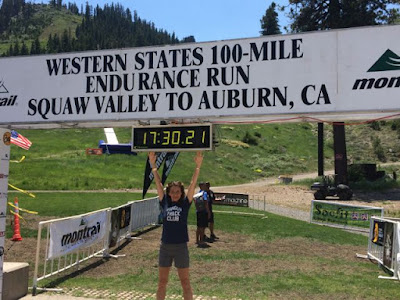 |
| At the start line the day before the race |
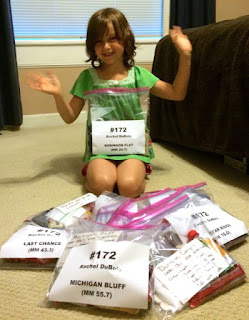 |
| Maddie helps me with drop bag preparations |
I had
traveled out to CA in May to attend the training camp runs and successfully
previewed the last 70 miles of the course over a 3 day period.
Planning is my strength,
and it has often times made up for my meager running talents, so I had planned
the snot out of this thing. Spreadsheets
galore, drop bag check lists, exact calorie requirement calculations, laminated
pocket size ETA and cutoff cheat sheets, first aid kits heavy on the foot
doctoring supplies, contingency plan upon contingency plan…
I also had the support, energy and expertise of an awesome crew and pacers that I would rely upon to
help me successfully complete my journey. Now all I had to do was run 100 miles through
the Sierras of CA in less than 30 hours.
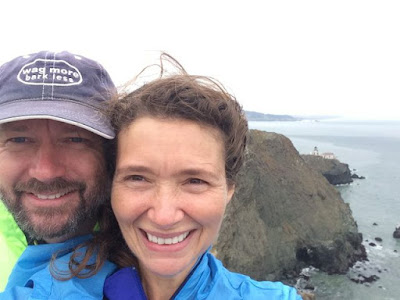 |
| Paul and I visiting the Point Bonita Lighthouse just north of San Francisco |
Race
activities began on Thursday and it was a whirlwind of check ins, runner
meetings, crew discussions, drop bag finalization and of course shopping at the
Western States store! I’m not much of a
shopper in my non-running life, but in a single outting I successfully revamped my entire
running wardrobe. Anything I even
half-heartedly glanced at ended up in our shopping basket thanks to my
husband’s generosity and support ;-)
 |
| Drop bag staging point |
My
crew/pacers were all finally gathered together in Squaw Valley by Friday afternoon. Jimbo was my local ace in the hole. He had been living all things Western States
for the last 6 years and had conveniently moved to the Auburn area from
Raleigh, NC just a few years ago. Jess,
another NC transplant, had driven out from the Bay area to support me. My dear friend from my AT thru-hiking days,
Jenn, had flown in from Boulder, CO. It
had been a dozen years since we had seen one another, so this was a special
treat. While normally Paul is at these races to
support and crew and sometimes even pace me, we had agreed in advance that he
would be spending this particular race weekend wrangling our two daughters,
which very well might have been more exhausting than running the 100.
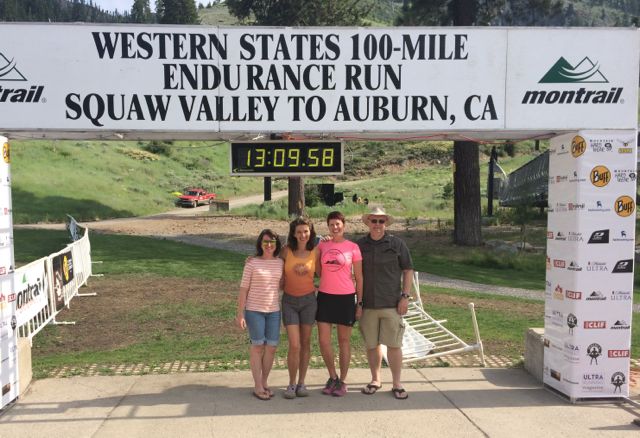 |
| Jess, me, Jenn, and Jimbo (my "J-Team"). The countdown clock is running. |
There’s an
amazing vibe in Squaw Valley that I’d never experienced at this level in any
other ultra to date. Most of my previous
ultras were smaller, low key events.
Western is the equivalent of the Boston Marathon of ultra-running. It has strict qualification requirements, it's
the “dream” race for many ultra-runners, Western attracts elite level athletes from
around the world, the field of participants is much larger than most other ultras, and the race and course have a rich and
storied history as the oldest 100 miler in the world (first running was in
1974).
The Western States Endurance Run is conducted along the Western States Trail starting at Squaw Valley, California (site of the 1960 Winter Olympics) and ending in the small town of Auburn, in the heart of California's historic gold country . Most of the trail passes through remote and rugged territory. Over its 100+ mile long length, participants climb a total of 18K vertical feet and descend an impressive 22.9K feet.
The Western States Endurance Run is conducted along the Western States Trail starting at Squaw Valley, California (site of the 1960 Winter Olympics) and ending in the small town of Auburn, in the heart of California's historic gold country . Most of the trail passes through remote and rugged territory. Over its 100+ mile long length, participants climb a total of 18K vertical feet and descend an impressive 22.9K feet.
Race morning
came early, as it almost always does. As
Paul and I walked down the hotel corridor, I told him I felt like one of the
Apollo astronauts going down the ramp to the shuttle and prepping for
launch. I knew that there were many
runner friends who were living vicariously through me this weekend and I had a
ton of family and friends that would be following along through the online live
tracking feeds.
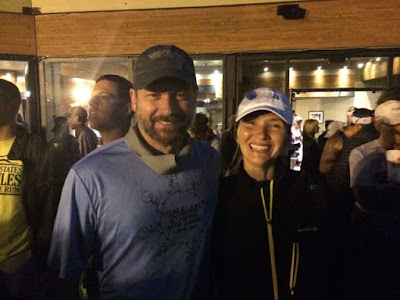 |
| Paul and me just moments before the start |
My crew were at the start line with coffees in hand ready to send me off into the wilds. Last minute good wishes, words of advice and hugs all around. Before we knew it, the starting shotgun was fired and we were on our way!
The race
starts off with a 3 mile/2k’ climb up the escarpment. Our family had done this climb in the days
prior – by ski gondola! The views are
spectacular and runners enjoyed a breathtaking sunrise as we crested the escarpment. It included a view all the way to Lake Tahoe
in the distance behind us.
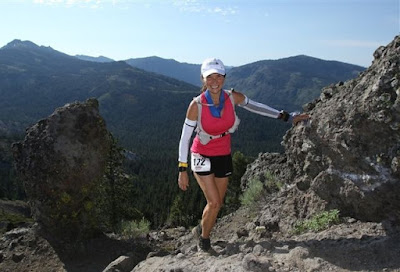 |
| All smiles at the crest of Cougar Rock |
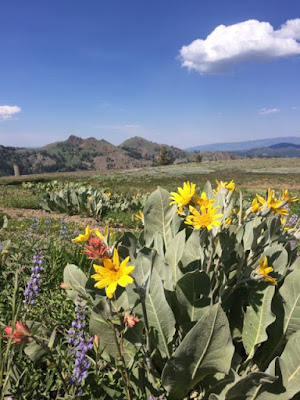 |
| Wildflower bouquets |
Temps at the
6 am start were a toasty 70F and it wasn’t long before they began to
climb with the rising sun. Forecasts called
for temps in the 90s with highs in the upper 90s and possible three digit temps
in the canyons.
I had
purchased some cooling arm sleeves in the days prior to the race and broke one
of the golden rules of racing – I tried something new on race day. The arm sleeves were made of a special
evaporative cooling fabric. If you wet
them, they get cold! It was really
impressive how quickly they dropped the temp of the skin on my arms. Climbing the escarpment I had to fiddle with
them quite a bit as they were too large for my scrawny biceps. I ultimately scavenged some safety pins from
my race bib and pinched in the fabric enough to get them to stay up. They were the bomb! And it wasn’t long before
I figured out a way to squeeze the bite valve on my hydration bladder hose to regularly douse
them with water.
The first
20+ miles of the race were hugely enjoyable.
The scenery was stunning and all new to me as the beginning of the
course had not been a part of the training camp preview runs. Add in the great company of other upbeat,
positive runners who were still feeling good and facing the day with optimism and
you’ve got the beginnings of a magical day.
Coming into
Duncan Canyon at mile 23.8 was my first chance to see my crew. I was already beginning to feel a few hot
spots on my feet and opted to pause here to address the issues before they
escalated. As I came into the aid
station, I was all smiles and happiness.
My crew was anxiously awaiting me.
I let them know that I needed to do a 10 minute reset to take care of
the feet. They quickly settled me into a
chair with the help of aid station volunteer angel, Lauren, and while Jimbo
(brave man) addressed my foot issues, Jess and Jenn plied me with food and
drink, switched me from my hydration vest to my HydraQuiver, and wrapped my
neck in an ice filled Cool-It bandana. I
had come into Duncan Canyon 27 minutes ahead of cutoff. Perfect!
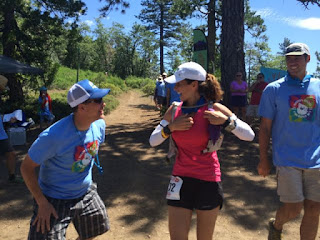 |
| So happy to see familiar faces - Lauren, my aid station angel |
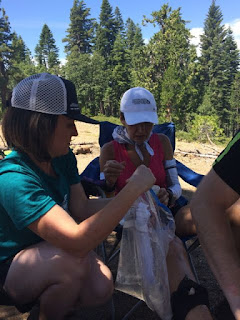 |
| My pit crew hard at work |
After having been seated for a while, the aid station captain came over to make sure I knew I was starting to get close to the cutoff. We sped things up, I put on some fresh socks, donned my shoes and made it out of there with around 15 minutes to spare stopping briefly at the sponge down station to get my arm sleeves thoroughly soaked. I was in good spirits and the foot fixes (fresh socks, preventative taping with rock tape and the application of a gel blister patch) worked wonders for me.
It was now approaching
the heat of mid-day. Year after year of
wild fires had ravaged large sections of the course leaving many miles of
barren, exposed trail that had no shade to offer. Runners
were starting to “feel the heat” and it was beginning to take its toll on many
of us. From Duncan Canyon aid station,
we faced a short descent to Duncan Creek and then a long, exposed, dusty, four
mile climb to Robinson Flat. This was
where I began to see the first signs of carnage.
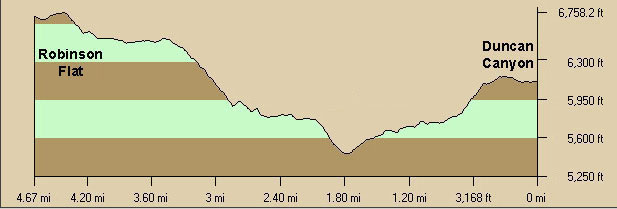 |
| The climb to Robinson Flat. (Travel direction is from right to left.) |
All of the
runners in my vicinity were facing the same time issues I was to make that next
cutoff. We couldn’t let up on that
climb, or we risked not making it. Some
pushed too hard, and succumbed to dizziness, nausea and vomiting. I tried to stay focused, keep a steady strong
hiking pace and used my water bottle to wet my arm sleeves. It was way tougher than I had ever expected,
but I made it to the aid station with just 12 minutes to spare.
The aid
stations have a warning system for runners.
20 minutes before cutoff, they sound a short air horn blast. 10 minutes, a longer blast. At cutoff, there is the final death knell – a
long, drawn out air horn blast. Robinson
Flat was where my nightmare experience with the air horns began, and they would
haunt me for many more miles. I heard
the first warning horn blast as I was approaching Robinson Flat. I flew threw the aid station. I never asked for my drop bag, I barely
stopped to top off my fluids and I headed back out.
Now I was on
trail that I had covered during the very first day of the training runs. Oddly enough, nothing looked familiar. I felt disoriented and had a hard time
recognizing the trail. All I remembered from
the training runs was the very pleasant and runable sections of trail leaving
Robinson, so it was disheartening to face yet one more mile of climbing as I
left the aid station. As I struggled up
this last bit of uphill, I heard yet another warning horn sounding behind
me. I couldn’t get out of there fast
enough.

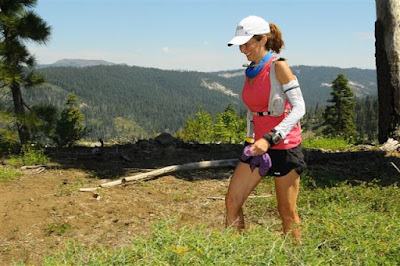
No comments:
Post a Comment